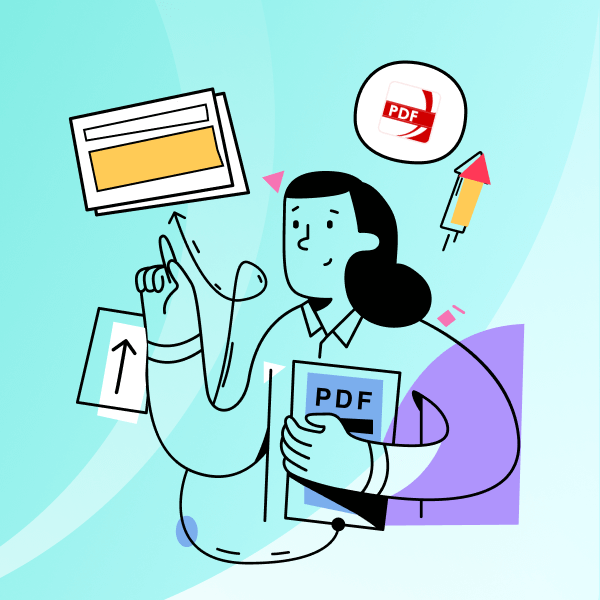Bates numbering is a method used for indexing legal documents for easy identification and retrieval.
In PDFs, Bates numbering adds a unique code at the header or footer of documents, enhancing file organization and access.
This guide will explain how to apply Bates numbering to your PDFs, enhancing document management and efficiency.
- The PDF Tool That Simplifies Bates Numbering
- What is Bates Numbering?
- How to Add Bates Numbers to PDFs: Windows
- How to Add Bates Numbers to PDFs: Mac
- Use Cases for Bates Numbering
- Bates Numbering FAQ
The PDF Tool That Simplifies Bates Numbering
Mastering Bates Numbering can be quite a complicated process, which is why you need a PDF tool that is built to handle complex needs.
PDF Reader Pro was created to help professionals across various fields, with Bates Numbering being one of the many processes it can simplify, organize, and allow you to master.
Level up your PDF management and simplify your Bates numbering application and PDF file security!

PDF Reader Pro is also my go-to tool for all my PDF needs due to its unique annotation and editing capabilities!
What is Bates Numbering?
Bates numbering is indexing legal documents for easy identification and retrieval.
Each document page is assigned a unique Bates number, which typically consists of a combination of numbers and sometimes letters, allowing for precise reference and organization.
This system is widely used in legal, medical, and business environments to manage large volumes of documents and ensure that every page can be uniquely identified and located quickly. Typically, these numbers are embedded in the headers or footers of a PDF to ensure structured organization.
Typically, these numbers are embedded in the headers or footers of a PDF to ensure structured organization.
How to Add Bates Numbers to PDFs: Windows
Understanding the application of Bates Numbers is imperative, especially for those in the legal, business, and medical fields. Here's a step-by-step guide:
Step 1: Open File
Open PDF Reader Pro and click on "Open File".

Step 2: Under Editor
Click on "Editor", and click on "Bates Numbers" and "Add Bates Numbers".

Step 3: Enter Bates Numbers
Enter the "Bates Numbers" within the position you want it on your PDF and click on "Apply". Correct the font, margin, and setting to your needs.
You can also "Batch" add Bates numbers when clicking "Batch" in the bottom left corner!
How to Use Bates Numbering in PDFs: Mac
Step 1: Open PDF File
Open PDF Reader Pro and click on "Open File".

Step 2: Under Editor
Click on "Editor", and click on "Bates Numbers" and "Add Bates Numbers".

Step 3: Enter Bates Numbers
Enter the "Bates Numbers" within the position you want it on your PDF and click on "Apply". Make sure to correct the font, margin, and setting to your needs.

You can also "Batch" add Bates numbers when clicking "Batch" in the bottom left corner!
Use Cases for Bates Numbering
Bates numbering has several key use cases across various fields, notably in legal, medical, and business sectors, where document management and retrieval are crucial. Here are some of the primary use cases:
- Legal Document Organization: In the legal industry, Bates numbering is essential for organizing case files, evidence documents, and discovery materials. It helps lawyers and legal professionals keep track of numerous documents and ensure easy access during trials or case preparation.
- Medical Records Management: In healthcare, Bates numbering aids in the organization and management of patient records, treatment histories, and other important medical documents. This facilitates quick retrieval of information for medical staff and ensures better patient care.
- Business Document Tracking: Businesses use Bates numbering to manage contracts, invoices, and other critical documents. It supports efficient document retrieval and helps maintain an organized record-keeping system.
- Audit and Compliance Documentation: For auditing purposes and compliance with regulatory standards, Bates numbering helps systematically organize all documents for easy access and review. This is particularly useful in industries subject to strict regulatory oversight.
- Research and Academic Work: Researchers and academics may use Bates numbering to organize research materials, references, and other scholarly work, making it easier to locate specific documents or pieces of information.
- Archiving and Preservation: For archives and libraries that preserve historical documents, Bates numbering is a method to catalog and retrieve documents efficiently, ensuring that each item can be found quickly among thousands or even millions of pages.
Bates Numbering FAQ
Is Bates numbering only for legal documents?
While Bates numbering is widely used in the legal field, it's not limited to legal documents. It can be applied to any collection of documents where sequential numbering could aid in organization and retrieval, such as medical records, business contracts, and academic research.
Are there alternatives to Bates numbering for document organization?
Yes, documents can also be organized using metadata tagging, date-time stamps, or custom indexing systems, depending on the organization's or project's needs.
Is Bates numbering secure?
Bates numbering itself does not secure a document but can be part of a document management strategy that includes security measures. Ensuring document security involves using encryption, access controls, and secure storage practices in addition to any document indexing system.
Can Bates numbering be automated?
Yes, many advanced document management and PDF editing tools offer automated Bates numbering, allowing users to apply sequential numbering to a batch of documents in one operation, saving significant time and reducing errors compared to manual numbering.
How does Bates numbering benefit document review and discovery?
Bates numbering streamlines the review and discovery process by providing a unique identifier for each page or document, making it easier to reference, cite, and locate specific documents or pages within a large collection.

 Free Download
Free Download Free Download
Free Download





